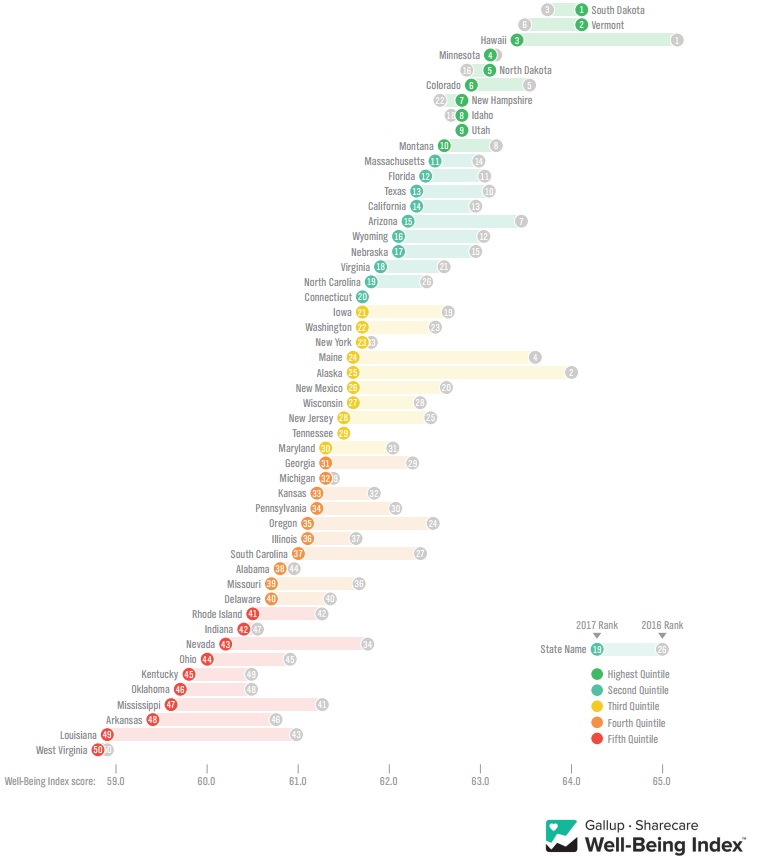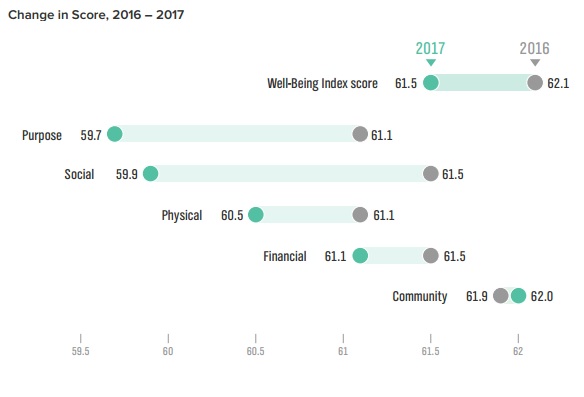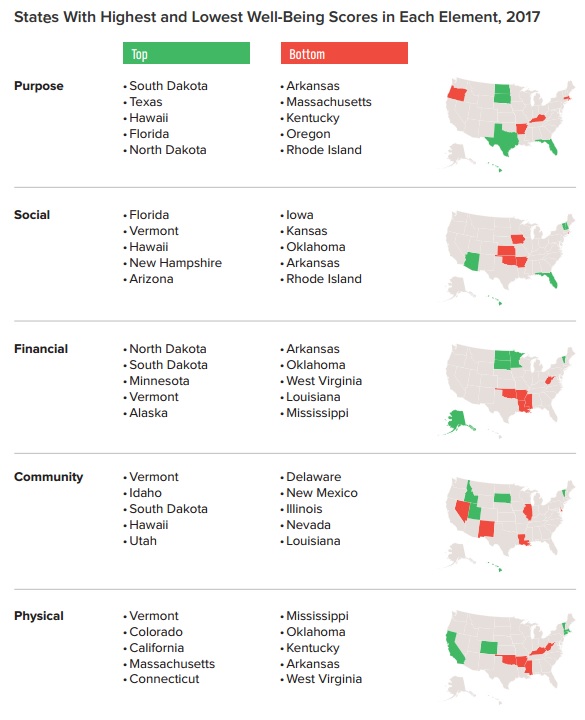The well-being and happiness of people in the United States took a hit in 2017, including the worst lows since the Great Recession. That’s according to the annual Gallup-Sharecare Well-Being Index results released this month.
Last year, America saw the greatest year-over-year decline in well-being and happiness, with 21 states receiving a lower score than in 2016. Not only did 2017 mark the biggest decline in the survey’s 10-year history, but it was also the first year in which not a single state improved in well-being, explains Dan Witters, the research director of the Well-being Index.
Each state’s well-being was calculated on a scale of 0 to 100, with 0 marking the lowest score and 100 the highest. The scores comprised the following five elements:
- Purpose: Liking what you do each day and being motivated to achieve your goals
- Social: Having supportive relationships and love in your life
- Financial: Managing your economic life to reduce stress and increase security
- Community: Liking where you live, feeling safe, and having pride in your community
- Physical: Having good health and enough energy to get things done daily
A nationally representative sample of 160,498 adults were interviewed for the 2017 rankings, adding to the Well-Being Index’s dataset of more than 2.5 million surveys since its 2008 start.
Here are the 10 U.S. states that have the unhappiest people and the lowest well-being scores:
10. Rhode Island (60.48)
9. Indiana (60.39)
8. Nevada (60.18)
7. Ohio (60.03)
6. Kentucky (59.85)
5. Oklahoma (59.66)
4. Mississippi (59.59)
3. Arkansas (59.36)
2. Louisiana (58.93)
1. West Virginia (58.80)

Western Virginia reported the lowest levels of well-being for the ninth consecutive year, while Louisianna fell to its lowest rank in the 10-year history of the Well-Being Index. Residents in West Virginia reported a low financial well-being score and hold the spot as the lowest scoring state for physical well-being.
“By looking through the data, there’s an inescapable pattern that enters the picture. It’s not physical fitness that has worsened, but the mental, emotional and psychological aspects of well-being that have worsened,” Witters tells CNBC Make It.
With even the highest ranking states reaching Well-Being Index scores of only mid-60s out of 100, Witters says “there is plenty of work to be done from a well-being perspective everywhere.”
For example, the percentage of people who said they frequently worry is up 32 percent, matching the previous high last experienced in 2009. Witters also saw a sharp uptick in people reporting little interest or pleasure in doing things up 7 percent or 17 million more people in 2017 than in 2016.
Diagnoses of clinical depression also reached the highest level since the Well-Being Index started: 11 percent of people reporting they are currently being treated for depression.

Witters points out that even with decreased obesity rates, more people are reporting feeling physical pain on a daily basis. “Physical pain can be a psychosomatic manifestation since mental health is currently worse and can lead to side effects like headaches,” Witters said.
As highlighted in the Well-Being Index report, many of the states which showed declines in well-being scores in 2017 worsened on the same set of metrics, including the following:
- A sharp uptick in reporting “little interest or pleasure in doing things”
- A decline in perceiving “positive energy” from friends and family members
- A reduction in having “someone who encourages you to be healthy”
- A drop in reports of liking “what you do each day”
- A decrease in those who have a leader in their lives who make them “enthusiastic about the future”
- Satisfaction with standard of living (compared to peers)
People in these low well-being states also tend to have a hard time setting and achieving goals in their life, Witters adds.
While millennials led the way in reducing smoking among Americans, improving exercise rates and eating more well-balanced diets than other generations, Witters explains that they have fallen behind on their social and mental well-being.
Still, “millennials have the chance to move America into a better, healthier future,” Witters says.

People in the top well-being states are more likely to feel a greater sense of satisfaction with where they live, get involved with impactful volunteering, manage their wealth well and feel able to live within their means, Witters says.
One of the main objectives of the Gallup-Sharecare partnership for the Well-Being Index, Witters says, is to identify and celebrate best practices across the nation for others to study and emulate.
Above all else, people who had a holistic sense of well-being — in which they equally have high rates of purpose, social, financial, community and physical well-being — tend to live happier, healthier lives.
Witters says this is where American millennials can really make a change in the country. “If you keep doing what you’re doing, that will be good for America,” he says. “To take it to the next level, start focusing more on these other aspects of well-being too.”
Like this story? Like CNBC Make It on Facebook.
Don’t miss:
 EU News Digest Latest News & Updates
EU News Digest Latest News & Updates



